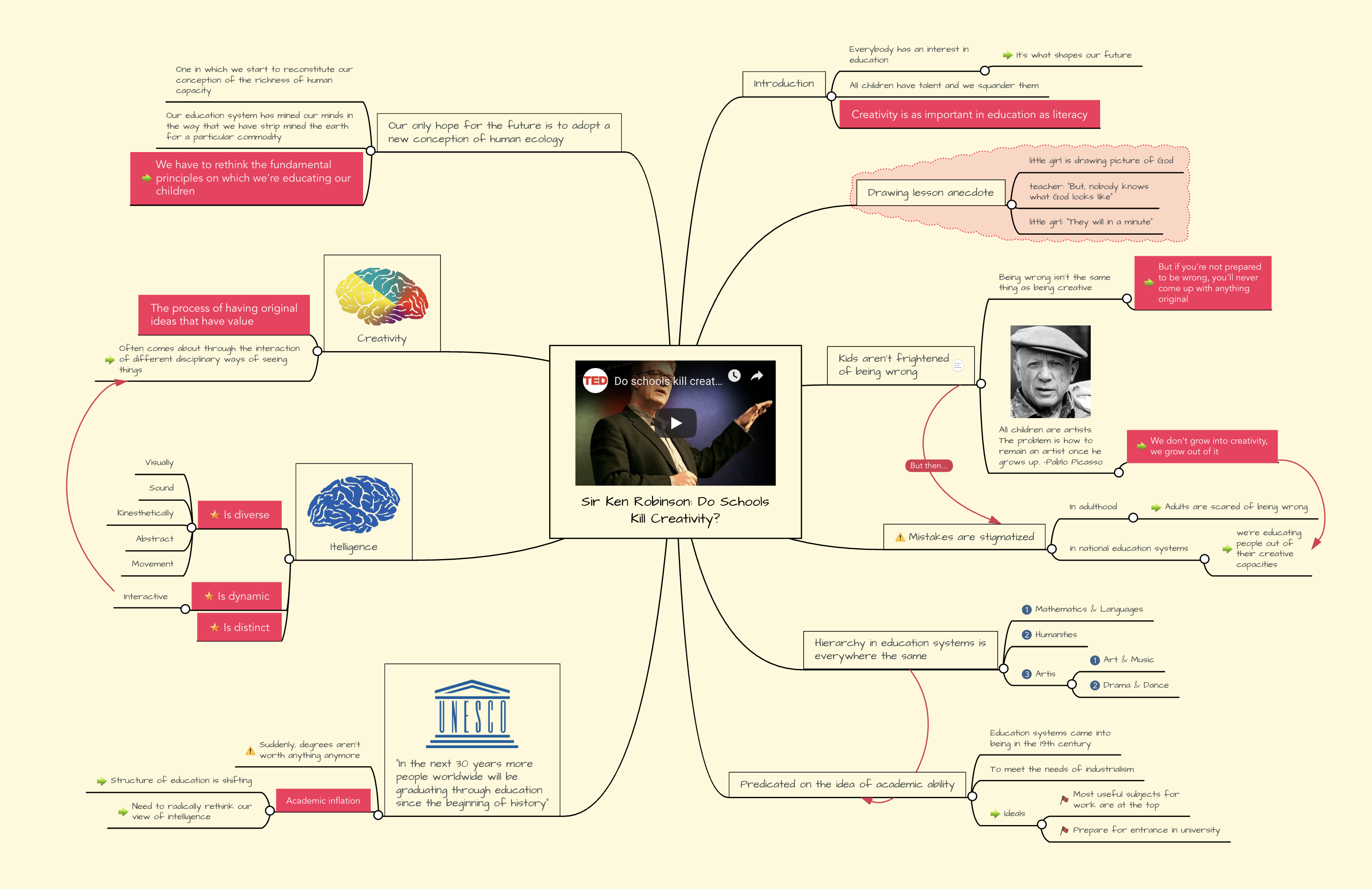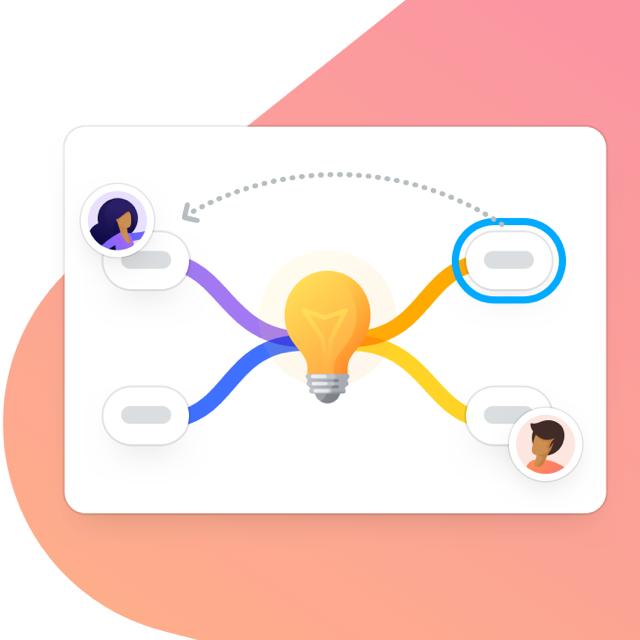To add new information to our long-term memory, we need to process it, comprehend it, connect it with our existing mental frameworks, and review it multiple times. The ability to take effective notes forms the basis for this process and is, therefore, an invaluable skill both in academic and in business contexts. Unfortunately, most of us are never actually taught how to take effective notes. But don’t worry, in this article, we’ll introduce you to one of the most effective note-taking methods and show you exactly how to apply it in everyday life.

The Problem with Linear Notes
Think about it: Throughout our academic careers, from first grade through to graduation, we are told what to learn, but the standard curriculum hardly ever includes lessons on how to learn. This is why so many students still spend their study time highlighting passages in textbooks and summarizing chapters, when research has conclusively shown that those study methods are actually the least effective. Similarly, linear notes are still the default format for note-taking for most people, even though it’s in many ways one of the least practical formats we could possibly choose. Here are just a few of the biggest problems with linear notes:
- Linear notes can be extremely monotonous, which makes them harder to memorize.
- Traditional note taking often feels laborious for us because it bores us mentally while it exhausts us physically (try writing for two hours straight and then see how your writing hand feels – probably not great!)
- Lined paper encourages us to write whole sentences, which is unnecessarily time-consuming and results in pages upon pages of information of which only a small percentage is actually important.
- Linear notes don’t provide a good overview of a topic. We often waste valuable time re-reading large chunks of our notes when looking for individual pieces of information.
- Once a page has been filled, it’s extremely hard to add additional information to it. We are forced to squeeze it in between the lines or add it at the bottom of the page with an asterisk.
- And what about taking notes in Word documents? Research has shown “that whereas taking more notes can be beneficial, laptop note takers’ tendency to transcribe lectures verbatim rather than processing information and reframing it in their own words is detrimental to learning.”
How to Take More Effective Notes with Mind Maps
A mind map is a visual diagram that lets you organize your notes in a two-dimensional structure. As opposed to linear notes, mind maps are usually created on a blank piece of paper or canvas, which is used in landscape mode instead of portrait. Instead of starting at the top left and filling the page until you’ve reached the bottom right, you start your mind map by writing the subject or headline in the center of the page; then you add your notes in the form of branches that radiate outwards from the center.
While this new way of making notes may feel a bit odd at first, it offers a range of benefits, especially if your goal is to retain information:
- A mind map shows relationships, hierarchies and connections between individual pieces of information at a glance.
- Mind maps provide a great overview of a topic because they store all your notes related to that topic on one single page.
- Mind maps encourage you to take fewer yet more meaningful notes. While you create the map, your brain actively processes the information instead of just mindlessly transcribing it.
- Mind maps use a number of mental triggers such as images, icons, colors and a two-dimensional structure that help you memorize their contents.
- You can always go back and add more details to your notes.
- Taking notes in a mind map is fun and feels more like doodling than actual work!
- Using mind mapping software such as MindMeister, you can also attach additional notes, links and whole files to your map and thus add a whole lot of information to it without diminishing the great overview it provides.
If you’ve never worked with mind maps before and want a complete guide on how to get started with mind mapping, you can check out our free online mind map training on MindMeister.com. If you’re already familiar with the basics, just keep reading to find out how to use mind maps to take effective notes in different situations and contexts:
1. Live Mind Mapping at a Conference
Let’s say you’re a marketer attending a conference about growth hacking. Most likely, you’re going for multiple reasons: to gain insights and learn new tricks from the speakers; to meet interesting people and make connections; or to join the discussion as a thought leader.
A great way to do all of these things is by taking notes in a mind map, and subsequently publishing and sharing your map.
Here’s how it works:
Before the conference starts, create a folder in MindMeister and name it after the conference. Download the conference program and create a new, blank mind map for each of the talks.
Open a mind map and create your first branch (topic) in the upper right corner. Note down the name of the speaker and add some details about him/her (such as his/her company name, website and Twitter handle). If you can extract his/her portrait from the program, paste it into the branch as well.

When a talk starts, open your prepared mind map to take notes, starting right below the first branch you’ve already created and going clockwise around the center.
Don’t try to transcribe the speaker verbatim, and don’t write down anything you don’t actually find valuable and interesting. The goal is to have a visual summary of the key takeaways that makes sense both to yourself and someone who hasn’t watched the talk yet.
Instead of whole sentences, use keywords and short phrases whenever possible. If needed, store longer explanations and details in the notes section of the topic.

Indicate relationships between ideas by drawing arrows with the connection tool.
Use icons, colors and font sizes to emphasize, highlight, number and group ideas.
Add images to the topics, either by selecting images from the MindMeister library, by using MindMeister’s WunderBild feature (this instantly adds a matching image from Google), by uploading an image from your computer or by pasting one from the internet.
As soon as the talk is over and your mind map is complete…
…publish the mind map to the web. This will automatically add it to MindMeister’s Public Maps Universe. While you’re at it, you can manually add it to the Biggerplate library for more exposure.

To give your map even more exposure, copy the link of your public map and paste it into a new tweet. Export the map as a PNG or simply take a screenshot of it, and attach this image to the tweet as well. Lastly, add a description of the map as well as the event hashtag to it. Then tweet it.
When you’re back at work and want to quickly share what you’ve learned at the conference with your colleagues, you can either invite them to the maps via email or turn the maps into slideshows and present them in a face-to-face meeting.
If you decide to implement some of the ideas shared at the conference, you can easily export those ideas as actionable tasks into MeisterTask, MindMeister’s integrated task management system.
2. Mind Mapping a Video
Cisco predicts that by 2017, videos will make up an incredible 69% of all consumer Internet traffic. Be it on YouTube or on an e-learning site such as Udemy, most of us watch documentaries, tutorial videos, TED talks, debates and lectures online on a daily basis. But how much of this valuable information that we see on the screen do we actually remember? Even the most inspiring TED talk is easily forgotten if all we do is watch it once. Watching it multiple times may help us remember it eventually, but really, who has the time to watch a video more than once nowadays?
So here’s what you can do:
Instead of leaning back while you watch your next TED talk, copy the video’s YouTube link and paste it into the center topic of a new, blank mind map. The video will automatically embed itself in the topic.
Press the play button on the embedded video and take notes in the mind map while it plays, starting at about 1 o’clock and going clockwise around the center.
Then follow the same steps as outlined in the conference section.
3. Taking Notes While Reading
Many teachers are already aware that mind maps are a fantastic tool to help students improve reading comprehension. But taking notes in a map while reading is not only beneficial for students.
Unless you happen to have an incredible memory, chances are that simply reading a text is not enough if you want to remember details of its content long-term. After only weeks of finishing a book, we’re often left with all but a vague notion.
If you want to ensure that your reading isn’t just a nice activity to pass time, you need to come up with a system to preserve all the valuable ideas, insights and lessons you read, so they can actually be utilized later on. Taking notes in a mind map while reading will help you to:
- gain a deeper understanding of the text
- make out connections you may otherwise have missed
- better remember what you’ve read
- refresh your memory and look up details quickly.
How to take notes in a mind map while reading
For print books
Create a new, blank mind map in MindMeister and write the title and author name in the center topic. Use the Google Image Search or MindMeister’s WunderBild feature to insert the cover of the book.
While you’re reading the first chapter, highlight those passages that you will want to remember, for instance with a highlighter pen or by marking the passages with a pencil.

When you’ve come to the end of the first chapter, go back to the beginning and start transcribing the highlighted passages into your mind map. Create the first topic at about 1 o’clock and go clockwise around the center.
Try to stick to short phrases and single keywords in the topics of your map. You may have to shorten and rephrase sentences, but that in itself is a valuable process that will help you transfer the information into your long-term memory. It also helps to keep the mind map simple and clutter-free.

- If needed, store longer explanations in the notes section of the topic.
- Indicate relationships between ideas with the connection tool.
- Use icons, colors and font sizes to emphasize, highlight and group ideas.
- Repeat these steps for each chapter of the book.
For e-books
If you’re reading e-books on your Kindle or a similar e-book reader, you can highlight important passages in the text while you’re reading it. Your highlights are all saved in the My Clippings.txt file, which you can copy to your computer using a USB cable once you’re finished reading.
Then, all you have to do is open the file and copy-paste the individual highlights into your prepared mind map.
The big advantage of this workflow is that you can comfortably read and highlight passages while you’re on the go, for instance on your commute to work, and then import your highlights into the mind map when you’re back in front of your computer.
Take More Effective Notes
Try MindMeisterSee also:






